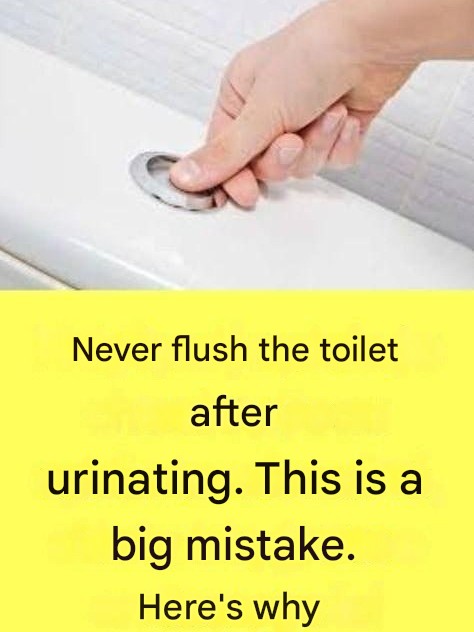ADVERTISEMENT
#### **The Environmental Toll of Plumbing Materials**
Toilets, pipes, and sewage systems are made of materials that have an environmental impact during production and installation. Additionally, wastewater treatment facilities require substantial energy and resources to handle the volume of waste generated by a society that flushes constantly. The less frequently you flush, the less you contribute to the overall wear on plumbing infrastructure.
### 4. **Hygiene and Health Considerations**
At first glance, it might seem unsanitary to leave urine in the toilet without flushing it immediately. However, research suggests that urine is actually relatively clean and poses no significant health risk when left in the toilet for short periods.
#### **Urine’s Composition**
Urine is primarily composed of water, urea, and various electrolytes. It contains no harmful bacteria under normal, healthy conditions. For most people, the act of urinating doesn’t create any immediate health hazards. That said, it’s important to recognize that urine’s contents can change based on diet, hydration levels, and underlying health conditions. For example, concentrated urine, which is often yellow in color, can contain higher levels of waste products, which could create an unpleasant odor.
#### **Minimizing Odor**
Although urine itself is not a major health concern, leaving it in the toilet for an extended period of time can lead to unpleasant odors. This is especially true in warm environments where bacteria can thrive and break down urea into ammonia, which creates a strong smell. However, for most people, waiting until later to flush after urination does not present significant hygiene risks.
Some people opt for using a toilet lid to trap the smell until they are ready to flush, while others may use air fresheners or essential oils to neutralize odors.
#### **Flushing During the Night**
For individuals who prefer not to flush during nighttime urination, a simple and effective way to minimize potential odors and maximize hygiene is to use a small amount of natural cleaner or deodorizing agent, such as a few drops of essential oils, after each use. This can help neutralize odors until a more convenient time for flushing.
### 5. **Cultural Norms and Social Perceptions**
There is a societal stigma surrounding the practice of not flushing after every urination. In many cultures, flushing the toilet immediately is seen as the “proper” thing to do. There are concerns about hygiene and embarrassment if others enter the bathroom and see that the toilet hasn’t been flushed.
However, social norms around bathroom habits are evolving. More and more people are becoming aware of the environmental and economic implications of unnecessary toilet flushing, and many are beginning to challenge traditional perceptions.
#### **Changing Social Perceptions**
The conversation around mindful water use and sustainability has started to shift how people view behaviors like flushing. As more people adopt environmentally conscious practices in other areas of life—such as recycling, using reusable products, and reducing waste—the idea of reducing unnecessary flushes is becoming less stigmatized.
It is important to realize that toilet habits are personal and can be adapted for individual or family preferences. If you are concerned about what others might think, one option could be to install a dual-flush toilet system, which allows you to choose between a low-water flush for liquid waste and a full flush for solid waste.
### 6. **Practical Tips for Reducing Flush Frequency**
If you’re interested in reducing the frequency of toilet flushing while maintaining a clean and hygienic bathroom environment, here are a few practical tips:
1. **Consider Installing a Dual-Flush Toilet**: These toilets allow you to choose a half-flush for liquid waste and a full flush for solid waste. By using the half-flush option for urination, you will reduce water usage.
2. **Use a Toilet Lid**: If you’re leaving urine in the toilet for any length of time, using the toilet lid will help minimize odors and keep the bathroom looking tidier.
3. **Air Fresheners and Essential Oils**: Keep air fresheners, essential oils, or natural deodorizers in the bathroom to help neutralize odors without the need to flush immediately.
4. **Flush Once a Day**: For households with multiple people, consider a strategy where you only flush once a day after all urinations have been made. This method is common in water-scarce regions and can be very effective when done consciously.
5. **Mindful Hydration**: Ensure you stay hydrated, as this can influence urine concentration and odor. Clear, diluted urine generally smells less potent.
### Conclusion
While it may feel counterintuitive, not flushing the toilet after every urination has significant benefits for water conservation, cost-saving, and reducing strain on plumbing systems. As we continue to face environmental challenges, it’s important to consider small, everyday changes that can make a big impact in the long run.
By rethinking the way we approach flushing, we can contribute to sustainability efforts and help preserve valuable water resources for future generations. Mindful toilet habits, combined with practical strategies and tools, can create a cleaner, more sustainable environment in your home and beyond. So the next time you use the bathroom, consider whether it’s truly necessary to flush immediately. Your actions can make a difference!
